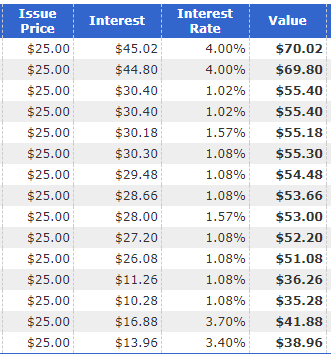How to Evaluate the Best Investments Based On Returns
The other day I remembered of some assets I have that would be a great example for evaluating investments. I didn’t actually get them for myself; my Nana did. She and Papa would intermittently buy bonds for the grandkids growing up; I’ve currently got about fifteen Series EE bonds that they bought at $25. The US Treasury lets you easily check their values (and interest rates) which I had never done before. I finally know how much they’re earning and… it could be better.

Whew, some of those returns are low. Granted this is all gravy for me, so it doesn’t really matter in the long run. Not even in these times of COVID and the second civil rights movement, apparently. But it does demonstrate the different returns you can get from the money you put into investments. Let’s talk about evaluating investments and choose which ones make the most sense for you.
The Minimum Investment Returns
Obviously, you want to invest in whatever will net you the most money. Duh. The issue with that is not knowing which investment will actually give you that. The safest investments – i.e. the ones that are best guaranteed to give you money – are also the ones that pay you the least. See the above bonds photo for evidence of that; bonds are one of the safest investments available, but that means rock-bottom returns on your investment.
So what return should an investment make you, minimum? For me, the answer is “beating inflation”. Only four of my fifteen bonds actually beat inflation, meaning those bonds will be worth less at their age of maturity than they are today. At the very least, you should accept a break-even point when you evaluate an investment. You didn’t earn anything, but you also didn’t lose anything, either. There’s some times where there’s more important things than your return (such as emergency funds, where the priority is having that cash on hand instead of having it grow). But outside of those specific cases you want to at the very least preserve your wealth.
Easy enough to use as a benchmark. The average inflation rate is 3% per year, so any investment you make needs to beat that 3% minimum. Consider 3% like a C grade: it’s the lowest passing grade you can get. You’ll still squeak by with that, you’re just not going to be in the upper echelons of school (or socioeconomic class).
Here’s another example: let’s say I have $1,000 that I want to invest. I don’t want to have less than my thousand in another five years’ time; I want to be richer, or at least break even. To break even, whatever investment I choose will have to earn at least $30 to beat inflation. Which, usually, is much easier said than done.
Evaluating the Types of Investments
There is a ridiculous number of things you can put your money towards in hopes of getting richer. Just watch a couple episodes of Shark Tank to see my point. Your money is capital that can be used to make more of it, which will hopefully be more than three percent. With the ideal being to grow your money, the most common avenues are via stocks, bonds, and real estate, with several branches of investments you can take off of those. Some give you a higher return, some lower. Some are a terrible place to put your money into, like most of my bonds. And some might perform differently than what you had expected them to.
Stocks are held up as the “high-risk, high-reward” option for investors. Everyone loves to believe they’ll invest early in the next FAANG company (Facebook, Apple, Amazon, Netflix, and Google) pointing to the outrageous returns their early investors got to pocket. With that said, it’s much more likely for companies to flop after you invest in them. Other companies will do great at first, then die a slow death years later. Three out of every four new businesses fail, with really no easy way to pick out the winners from the failures.
Ask yourself questions before going in.
You need to evaluate these things as you define what you want out of your investments – how long you plan to hold onto them for, how much of a return you expect from them, and how much energy you need to put into them to earn that return. Real estate, for example, has only outperformed the S&P 500 by 0.7% over the last 25 years; said real estate was also a lot more hands-on than the stock market requires, what with repairs, maintenance, insurance, and all the other costs that go into building upkeep. Is that extra zero-point-seven-percent worth the extra hassle? That’s up to you to decide when it’s your investment to consider.
Another Baseline: The Index Fund
It’s no secret that I’m a fan of stock market index funds. I stand by them even with the bit of flak I got for it.
Index funds are, for my own investing needs, the go-to baseline for evaluating your investments. Essentially, an index fund is investing in every publicly-traded company to capture the overall return. And that return has, on average, been a double-digit one at 10% historically. This is important to know because index funds also happen to be the most passive investment vehicle ever. I know I can get an average return of 10% from index funds without doing anything other than hitting a “buy” button and letting it go from there.
Which brings me to my point about why index funds are an amazing baseline. If it won’t give you more than 10% on average, you’re better off just buying more index shares and letting them do all the work for you. If you can’t see how an investment can make that much, guess what! It’s more likely to fail than it is to succeed!
If any other investment approach requires further work, I need to see extra results. I also need to be able and willing to invest more non-monetary things into the higher returns, namely my time and energy. At this point in time I’m more than happy with the 10% projected returns; in fact, my index funds have beaten that projection with a 13% return since 2017! Further returns will require much more from me than logging into my accounts every quarter. It’s not currently worth it to me, but that can be different for future Darcy… and for you.
Don’t Invest in What You Don’t Understand
This is the big decider of success if you choose to invest in something more specific than an index. The less you know about an investment, the harder it is to evaluate whether it’s actually worth it.
Should I ever decide to invest in something beyond index funds, I’ll invest ONLY in stuff I completely understand. If you want to know the potential returns of a marketing startup or finance app I’m your girl; if you want to know the same about skiing equipment or wines, I’d be just as likely to steer you horribly, horribly wrong. In other words, don’t let someone else convince you to invest in their crazy idea that you know nothing about. Your choices are to either defer until you can learn more, or to decide you’re cool with (potentially) flushing that money away.
Don’t forget about maintenance, either.
Besides evaluating, you’ll also have to maintain your investments in some way or another. The minimum is logging into your accounts a few times each year to check everything’s in order or if you need to rebalance. The maximum is spending every waking second poring over how to best make your pennies stack. Find your happy medium on that scale; for me right now that’s way on the left, where I really don’t have to check up on my investments at all.
I’ve discussed before how you need four things to do anything, which obviously includes investing. Those four things (time, energy, desire, and means) additionally serve as metrics for how much of each you want to spend on evaluating – and maintaining – your investments.
How you allocate these resources is up to you. You’re a wonderful human with a mix of desires, comfort levels, and knowledge unlike anyone else’s. Use it all to evaluate the investment allocation that works best for you. You might decide you just want to preserve what wealth you have, in which case a 3% return is ideal. Or you’re like me and decide to maximize your returns with the least babysitting possible, which puts your benchmark at a 10% return. For the most starry-eyed folks out there is an even higher return, but tread lightly. It comes as a serious risk, even with all of the research and paid advisors on the planet.
So however you choose to invest your money, make sure you’re really evaluating that investment first. It’s a skill that keeps you firmly on the climb to wealth, and what will give you the best guarantee of achieving your goals and dreams.
Cover image credit: Juan Rumimpunu via Unsplash

